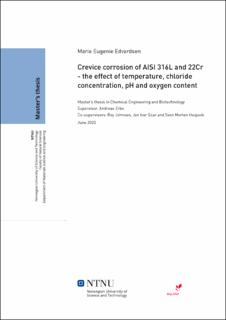| dc.contributor.advisor | Erbe, Andreas | |
| dc.contributor.advisor | Johnsen, Roy | |
| dc.contributor.advisor | Skar, Jan Ivar | |
| dc.contributor.advisor | Hesjevik, Sven Morten | |
| dc.contributor.author | Edvardsen, Marie Eugenie | |
| dc.date.accessioned | 2021-09-28T18:03:38Z | |
| dc.date.available | 2021-09-28T18:03:38Z | |
| dc.date.issued | 2020 | |
| dc.identifier | no.ntnu:inspera:59532294:34429428 | |
| dc.identifier.uri | https://hdl.handle.net/11250/2785263 | |
| dc.description.abstract | Korrosjonsresistente legeringer, som for eksempel rustfrie stål, blir ofte brukt i offshore-installasjoner på grunn av deres høye motstand mot generell korrosjon. Rustfrie stål er imidlertid utsatt for lokal korrosjon, som spaltekorrosjon under spesifikke forhold. Spaltekorrosjonsmotstand påvirkes av forskjellige miljøparametere, som temperatur, kloridkonsentrasjon, pH og oksygeninnhold. Oksygeninntrengning i prosess- og produksjonssystemer kan være skadelig for korrosjonsresistente legeringer, og en oksygenapplikasjonsgrense på 10 ppbw brukes som en generell praksis. Nyere forskning har indikert at oksygengrensen kan være høyere. En høyere grense vil være lønnsomt med tanke på økonomi, drift og materialvalg.
Målet med denne avhandlingen er å undersøke effekten av forskjellige miljøparametere på spaltekorrosjon av AISI 316L rustfritt stål og 22% Cr dupleks rustfritt stål i et miljø med lite oksygen. Begge materialene anses å være viktige rustfrie stål og er mye brukt. En gjennomgang av litteratur om effekten av forskjellige miljøparametere på spaltekorrosjon av rustfritt stål og oksygengrensen ble gjennomført, i tillegg til eksperimentelt arbeid.
Det eksperimentelle arbeidet inkluderte opptak av anodisk syklisk potensiodynamisk polariseringskurver og målinger av åpen krets potensialet. Ved å bruke ASTM G61-standard ble anodisk syklisk potensiodynamisk polariseringskurver ved forskjellige temperaturer, kloridkonsentrasjoner og pH tatt opp. Begge materialene ble testet i elektrolytter med 600 ppmw, 5000 ppmw og 120 000 ppmw klorid ved både 30 °C og 95 °C i pH-området 4.1 - 8.5. Resultatene viste at spaltekorrosjonspotensialet og repassiveringspotensialet til begge materialene avtok med økende kloridkonsentrasjon og temperatur. Spaltekorrosjonsmotstanden til både AISI 316L rustfritt stål og 22% Cr dupleks rustfritt stål er lavere ved høyere temperaturer og kloridkonsentrasjoner. Høyere kloridkonsentrasjon og temperatur gjorde det også vanskeligere for overflaten å repassivere. 22% Cr dupleks rustfritt stål viste den høyeste korrosjonsmotstanden av de to materialene. pH hadde liten effekt på spaltekorrosjonspotensialet og repassiveringspotensialet i det testede pH-området. Åpen krets potensialet økte med økende oksygeninnhold og avtok med økende temperatur. Begge materialene hadde en oksygengrense på < 10 ppbw oksygen i løsning med 120 000 ppmw klorid ved 95 °C. Åpen krets potensial målinger med ulike oksygen innhold bør gjennomføres for å etablere oksygenapplikasjonsgrenser ved de andre testforholdene. | |
| dc.description.abstract | Corrosion resistant alloys, such as stainless steels are often used in offshore installations due to their high resistance towards general corrosion. Stainless steels are however susceptible to localized corrosion, such as crevice corrosion at specific conditions. Crevice corrosion resistance is affected by various environmental parameters, such as temperature, chloride concentration, pH and oxygen content. Oxygen ingress in the process and production systems can be damaging for corrosion resistant alloys and an oxygen application limit of 10 ppbw is used as a general practice. Recent research has indicated that the oxygen limit may be higher. An increased limit would be beneficial in terms of economy, operation and material selection.
The aim of this thesis is to investigate the effect of different environmental parameters on crevice corrosion of AISI 316L stainless steel and 22% Cr duplex stainless steel in a low oxygen environment. Both materials are considered to be important stainless steels and are widely used. A review of literature regarding the effect of different environmental parameters on crevice corrosion of stainless steels and the oxygen limit were conducted, in addition to experimental work.
The experimental work included recording of anodic cyclic potentiodynamic polarization curves and open circuit potential measurements. By using ASTM G61 standard, anodic cyclic potentiodynamic polarization curves at different temperatures, chloride contents and pH were recorded. Both materials were tested in electrolytes with 600 ppmw, 5000 ppmw and 120 000 ppmw chloride at both 30 °C and 95 °C in the pH region 4.1 - 8.5. The results showed that the crevice corrosion potential and the repassivation potential of both the materials decreased with increasing chloride concentration and temperature. The crevice corrosion resistance of both AISI 316L stainless steel and 22% Cr duplex stainless steel are lower at higher temperatures and chloride concentrations. Higher chloride concentration and temperature made it more difficult for the surface to repassivate as well. 22% Cr duplex stainless steel showed the highest corrosion resistance of the two materials. pH had little effect on the crevice corrosion potential and repassivation potential in the tested pH range. The open circuit potential increased with increasing oxygen content and decreased with increasing temperature. Both materials had an oxygen application limit of < 10 ppbw oxygen in solution with 120 000 ppmw chloride at 95 °C. Open circuit potential measurements with different oxygen contents should be conducted to establish oxygen application limits at the other test conditions. | |
| dc.language | | |
| dc.publisher | NTNU | |
| dc.title | Crevice corrosion of AISI 316L and 22Cr - the effect of temperature, chloride concentration, pH and oxygen content | |
| dc.type | Master thesis | |
